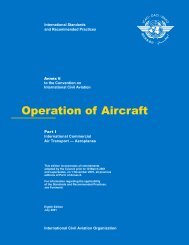Aircraft Operations
Doc 8168 Aircraft Operations, Volume I Flight Procedures
Doc 8168 Aircraft Operations, Volume I Flight Procedures
- No tags were found...
You also want an ePaper? Increase the reach of your titles
YUMPU automatically turns print PDFs into web optimized ePapers that Google loves.
Part II — Section 3, Chapter 1<br />
II-3-1-7<br />
1.4.15 The pilot shall ensure that the receiver is sequenced to the appropriate waypoint for the segment of the<br />
procedure being flown, especially if one or more flyovers are omitted (FAF rather than IAF if the procedure turn is not<br />
flown). The pilot may have to bypass one or more flyovers of the same waypoint in order to start GNSS sequencing at<br />
the proper place in the sequence of waypoints.<br />
1.4.16 For FMC installations providing a control display unit or graphical user interface and an electronic map<br />
display, the pilot should have sufficient situational awareness and means to conveniently monitor and ensure that the<br />
procedure to be flown is consistent with the cleared procedure.<br />
1.4.17 GNSS procedures are developed based upon features built into the basic GNSS receiver. These features are<br />
provided to permit a reduced flight technical error (FTE) as a result of increasing the sensitivity of the CDI at specific<br />
points during the approach.<br />
1.4.18 For FMC installations, the same may be true where pilot tracking performance relies on the CDI. In the<br />
cases where flight director guidance cues or FMC/autopilot coupled operation is provided, along with an electronic<br />
map display, the FTE is managed and reduced based upon the choice of guidance control as well as the method of<br />
displaying the tracking information.<br />
1.4.19 All FMCs and some stand-alone basic GNSS receivers provide altitude information. However, the pilot<br />
must still comply with the published minimum altitudes using the barometric altimeter. Where the FMC provides<br />
vertical information, flight director guidance cues, or coupled autopilot operation, the pilot should follow the<br />
appropriate information or cues along with any necessary cross checks with the barometric altimetry.<br />
1.4.20 The equipment will automatically present the waypoints from the IAF to the MAHF, unless a manual pilot<br />
action has already been taken.<br />
1.4.21 Sequencing at the MAPt<br />
1.4.21.1 Basic GNSS equipment may not automatically sequence to the next required waypoint. In this case, it<br />
may be necessary to manually sequence the GNSS equipment to the next waypoint.<br />
1.4.21.2 An FMC will provide for automatic sequencing.<br />
1.4.22 Radar vectors<br />
1.4.22.1 With basic GNSS stand-alone equipment, it may be required to manually select the next waypoint so that<br />
GNSS is correctly using the appropriate database points and associated flight paths.<br />
1.4.22.2 For FMC installations, the systems typically provide what is known as a “direct-to” capability to support<br />
radar vectors under FMC guidance.<br />
1.5 INITIAL APPROACH SEGMENT<br />
1.5.1 Offset IAFs<br />
1.5.1.1 Offset IAFs in procedures based on the “Y” or “T” bar design concept for basic GNSS are aligned such<br />
that a course change of 70° to 90° is required at the IF. A capture region is associated with each IAF of the basic GNSS<br />
procedure from which the aircraft will enter the procedure. The capture region for tracks inbound to the offset IAFs<br />
23/11/06












